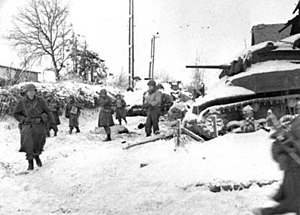Ardennes-Alsace Campaign
| Battle of the Bulge | |||||||
|---|---|---|---|---|---|---|---|
| Part of World War II | |||||||
 American soldiers of the 117th Infantry Regiment, Tennessee National Guard, part of the 30th Infantry Division, move past a destroyed American M5A1 "Stuart" tank on their march to recapture the town of St. Vith during the Battle of the Bulge, January 1945. |
|||||||
|
|||||||
| Belligerents | |||||||
|
|
|||||||
| Commanders and leaders | |||||||
| Strength | |||||||
|
|
||||||
| Casualties and losses | |||||||
|
|||||||
| Approximately 3,000 civilians killed | |||||||
Allied victory
The Battle of the Bulge (16 December 1944 – 25 January 1945) was the last major German offensive campaign of World War II. It was launched through the densely forested Ardennes region of Wallonia in Belgium, France, and Luxembourg, on the Western Front, towards the end of World War II, in the European theatre. The surprise attack caught the Allied forces completely off guard. American forces bore the brunt of the attack and incurred their highest casualties of any operation during the war. The battle also severely depleted Germany's armoured forces on the Western Front, and they were largely unable to replace them. German personnel and later, Luftwaffe aircraft (in the concluding stages of the engagement), also sustained heavy losses.
The Germans officially referred to the offensive as Unternehmen Wacht am Rhein ("Operation Watch on the Rhine"), while the Allies designated it the Ardennes Counteroffensive. The phrase "Battle of the Bulge" was coined by contemporary press to describe the bulge in German front lines on wartime news maps, and it became the most widely used name for the battle. The German offensive was intended to stop Allied use of the Belgian port of Antwerp and to split the Allied lines, allowing the Germans to encircle and destroy four Allied armies and force the Western Allies to negotiate a peace treaty in the Axis powers' favor. Once that was accomplished, the German dictator Adolf Hitler believed he could fully concentrate on the Soviets on the Eastern Front. The offensive was planned by the German forces with utmost secrecy, with minimal radio traffic and movements of troops and equipment under cover of darkness. Intercepted German communications indicating a substantial German offensive preparation were not acted upon by the Allies.
...
Wikipedia
